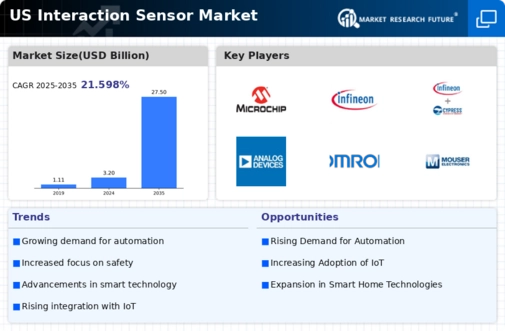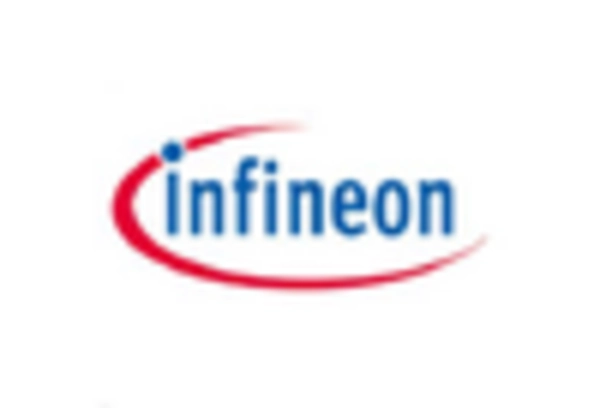The interaction sensor market is currently characterized by a dynamic competitive landscape, driven by rapid technological advancements and increasing demand across various sectors, including automotive, consumer electronics, and industrial automation. Key players such as Texas Instruments (US), Honeywell (US), and STMicroelectronics (FR) are strategically positioned to leverage innovation and partnerships to enhance their market presence. Texas Instruments (US) focuses on developing advanced sensing technologies that integrate seamlessly with IoT applications, while Honeywell (US) emphasizes its commitment to sustainability and energy efficiency in sensor solutions. STMicroelectronics (FR) is actively pursuing regional expansion, particularly in North America, to capitalize on the growing demand for smart sensors in automotive applications. Collectively, these strategies contribute to a competitive environment that is increasingly oriented towards innovation and technological integration.
In terms of business tactics, companies are localizing manufacturing and optimizing supply chains to enhance operational efficiency and responsiveness to market demands. The market structure appears moderately fragmented, with several key players exerting influence while also facing competition from emerging firms. This fragmentation allows for a diverse range of products and solutions, catering to various customer needs and preferences.
In October 2025, Honeywell (US) announced a strategic partnership with a leading automotive manufacturer to develop next-generation interaction sensors aimed at enhancing vehicle safety and user experience. This collaboration is significant as it aligns with the growing trend towards smart vehicle technologies, positioning Honeywell to capture a larger share of the automotive sensor market. The partnership is expected to leverage both companies' strengths in sensor technology and automotive engineering, potentially leading to innovative solutions that meet evolving consumer expectations.
In September 2025, Texas Instruments (US) launched a new line of interaction sensors designed for smart home applications, emphasizing energy efficiency and user-friendly interfaces. This product introduction is crucial as it reflects the company's commitment to addressing the increasing consumer demand for smart home technologies. By focusing on energy-efficient solutions, Texas Instruments aims to differentiate itself in a competitive market, appealing to environmentally conscious consumers and businesses alike.
In August 2025, STMicroelectronics (FR) expanded its production capabilities in the US to meet the rising demand for automotive sensors. This expansion is indicative of the company's strategic focus on enhancing its manufacturing footprint in key markets, allowing for quicker response times and improved supply chain reliability. By increasing production capacity, STMicroelectronics positions itself to better serve the growing automotive sector, which is increasingly reliant on advanced sensor technologies for safety and automation.
As of November 2025, current trends in the interaction sensor market are heavily influenced by digitalization, sustainability, and the integration of artificial intelligence (AI). Strategic alliances are becoming increasingly important, as companies seek to combine expertise and resources to drive innovation. The competitive landscape is shifting from traditional price-based competition to a focus on technological advancement and supply chain reliability. This evolution suggests that companies that prioritize innovation and strategic partnerships will likely emerge as leaders in the market, shaping the future of interaction sensor technologies.















Leave a Comment